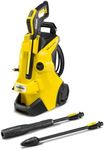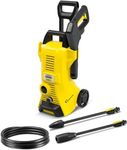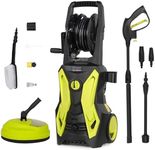Buying Guide for the Best Pressure Washer For Patio
Choosing the right pressure washer for your patio can make a significant difference in how effectively and efficiently you can clean outdoor surfaces. Pressure washers come in various types and with different features, so it's important to understand what to look for to ensure you get the best fit for your needs. Here are some key specifications to consider when selecting a pressure washer for your patio.Pressure (PSI)PSI stands for pounds per square inch and measures the pressure output of the washer. This spec is important because it determines how powerful the water stream will be. For light cleaning tasks, such as washing cars or patio furniture, a pressure washer with 1300-2000 PSI is sufficient. For more demanding tasks like cleaning patios, driveways, or removing tough stains, look for a model with 2000-3000 PSI. If you have very stubborn dirt or large areas to clean, you might need a pressure washer with over 3000 PSI. Choose the PSI based on the type of cleaning you need to do most often.
Water Flow Rate (GPM)GPM stands for gallons per minute and measures the water flow rate of the pressure washer. This spec is important because it affects how quickly you can clean a surface. A higher GPM means more water is being used, which can help rinse away dirt faster. For general patio cleaning, a GPM of 1.5-2.5 is usually adequate. If you need to clean larger areas or want to complete tasks more quickly, look for a model with a higher GPM. Consider the size of your patio and how often you plan to use the pressure washer to determine the right GPM for you.
Power SourcePressure washers can be powered by electricity or gas. Electric models are typically lighter, quieter, and easier to maintain, making them suitable for small to medium-sized patios and occasional use. They usually have lower PSI and GPM ratings. Gas-powered models are more powerful and can handle larger areas and tougher cleaning jobs, but they are heavier, noisier, and require more maintenance. Choose an electric model if you have a smaller patio and prefer a quieter, low-maintenance option. Opt for a gas model if you have a larger area to clean or need more power for tough stains.
Nozzle TypesPressure washers come with different nozzle types that control the spray pattern and intensity. This spec is important because it allows you to adjust the water stream for different cleaning tasks. Common nozzle types include 0-degree (very concentrated stream), 15-degree (narrow spray), 25-degree (medium spray), and 40-degree (wide spray). Some models also come with adjustable or turbo nozzles. For patio cleaning, a 25-degree or 40-degree nozzle is usually sufficient. Consider the types of surfaces you will be cleaning and choose a pressure washer with the appropriate nozzles for versatility.
Hose LengthThe length of the hose determines how far you can move around without having to move the pressure washer unit. This spec is important for convenience and ease of use. A longer hose allows you to clean larger areas without constantly repositioning the machine. For small patios, a hose length of 20-25 feet is usually sufficient. For larger patios or more extensive cleaning tasks, look for a hose length of 30 feet or more. Consider the size of your patio and how much mobility you need when choosing the hose length.
PortabilityPortability refers to how easy it is to move the pressure washer around. This spec is important for ease of use, especially if you have a large patio or need to transport the washer to different locations. Look for features like wheels, handles, and overall weight. Lighter models with sturdy wheels and ergonomic handles are easier to maneuver. If you have a large area to clean or need to move the washer frequently, prioritize portability features to make the task less cumbersome.















